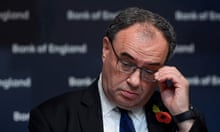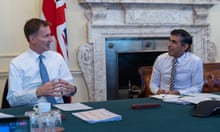Jeremy Hunt has warned that decisions of “eye-watering difficulty”, including cuts to public spending, will be required to repair the damage to the government’s finances after the failed mini-budget.
After his screeching U-turn to scrap the unfunded tax promises made by his predecessor, Kwasi Kwarteng, expectations are rising that the chancellor will kickstart a renewed austerity drive as part of debt-cutting plans due to be announced on 31 October.
Uncertainty over the precise shortfall in the public finances remains without the publication of an official forecast from the Office for Budget Responsibility. However, the Resolution Foundation thinktank estimates up to £40bn of savings may be needed, coming close to the austerity drive launched by George Osborne in 2010.
Any such push would come on the back of more than a decade of cuts, leaving public sector services close to breaking point.
An analysis by the Institute for Fiscal Studies shows government departments have faced steep falls in their day-to-day budgets, with cuts of more than a quarter for areas including work and pensions, housing, communities and transport.
In its annual stocktake of public sector performance, the independent thinktank Institute for Government (IfG) warned funding for nine key areas – including health, neighbourhood services, schools and police – was unlikely to be enough to meet rising demand.
“Public services won’t have returned to pre-pandemic performance by the next election, which in most cases was already worse than when the Conservatives came to power in 2010,” it said in the report.
Despite the IfG’s assessment that “there is no more meaningful ‘fat’ to cut from public service budgets”, cuts look inevitable. Here we look at which areas of government spending are most vulnerable to Hunt’s austerity drive.
Overseas aid
2022-23 budget: £11.5bn
Austerity risk: 3/5
Overseas aid had been in Kwarteng’s crosshairs before his sacking as chancellor. It could be a prime area for Hunt to look at again for savings.
Boris Johnson’s government had controversially ditched a promise to spend 0.7% of GDP on foreign aid during the Covid pandemic, lowering it to 0.5% from spring 2021 to save billions of pounds despite a backbench Tory rebellion.
Keeping that looser pledge, or cutting it, would help Hunt find savings. However, he rebelled on the issue under Johnson. “To cut our aid budget by a third in a year when millions more will fall into extreme poverty will make not just them poorer but us poorer in the eyes of the world,” he said at the time.
Defence
2022-23 budget: £40.9bn
Austerity risk: 1/5
The defence secretary, Ben Wallace, has indicated he would be prepared to quit if Liz Truss’s government reneged on her campaign promise to spend 3% of GDP on defence by 2030, up from about 2% at present.
Defence is an area savings have been made in recent years, helping to accommodate rising health expenditure since the end of the cold war. Wallace’s sabre rattling appears to have led Truss to back off from scrapping the 3% promise.
Welfare and public sector pay
2022-23 budget (welfare): £250bn
Austerity risk: 4/5
Truss’ government is no longer publicly committed to the Tory 2019 manifesto promise to defend the pensions triple lock – the guarantee that state pensions rise each year in line with inflation, average wage growth, or 2.5%, whichever is highest.
Pensioner spending is the single biggest area of welfare spending, at more than £120bn, with unemployment, universal credit, disability and child benefit accounting for the rest.
after newsletter promotion
Annual uprating of pensions and benefits in line with inflation has been the default setting since the 1980s, barring periods when benefits were frozen, such as under Osborne in the 2010s. Hunt could save money with a freeze or a raise pegged to earnings growth, which is about half the current 9.9% inflation rate. However, this would probably come with a steep political cost and threaten a renewed backbench rebellion.
The state pension is forecast by the Resolution Foundation to rise by 70% between 2010 and 2027 as a result of the triple lock, compared with 54% for average pay, and a 46% rise for inflation. If this was sustained, the state pension could reach twice the value of the main rate of unemployment benefit by 2030.
Rebecca McDonald, the chief economist at the Joseph Rowntree Foundation, said it was crucial to raise benefits in line with inflation, after real-terms cuts in eight of the last 10 years. “Failing to do so would leave families on the lowest incomes facing historic cuts to their incomes, when what they need is stability and security.”
Holding down public sector pay could be tough for the chancellor, despite being an obvious candidate for an austerity-minded Conservative government. Johnson had pushed to cut the civil service headcount. However, sky-high inflation, the threat of strikes, staff shortages, and promises to hire more teachers, nurses and police, mean there is plenty of pressure for a bigger public sector wage bill.
The most recent official data shows annual private sector wage growth is running at 6.2%, compared with just 2.2% in the public sector, while inflation is running at about 10%. Many experts say this is unsustainable.
Health and social care
2022-23 budget: £169.9bn
Austerity risk: 2/5
The new chancellor’s record as health secretary has union leaders worried about what is to come. A drive to find cost savings here would be politically toxic, however, and come after years of ringfencing the health budget to protect it from cuts.
Truss’s decision to reverse this year’s national insurance rise means more than £18bn originally earmarked for health and social care funding has been scrubbed from the public finances. Despite this, ministers suggested last week that “not a single penny less” would go to social care and the NHS.
However, No 10 confirmed on Tuesday that the health budget was not exempt from the requirement for all departments to find savings. A key focus will be on whether spending levels are sufficient to meet Covid backlogs and growing demand from an ageing population.
Capital investment
2022-23 budget: £107.8bn
Austerity risk: 4/5
Johnson had made a big promise to boost capital investment – government spending on roads, railways and other big infrastructure projects – to the highest sustained levels since the late 1970s, as part of his levelling up agenda. Public investment had been planned to grow by £100bn a year in cash terms.
There is far less clarity about Truss’s commitment. However, economists warn capital investment is among the best ways to boost economic growth. Cuts here would risk undermining her “pro-growth” agenda.
Despite this, cuts to long-term spending are thought to be politically easier given the length of time they typically take to come to fruition.










